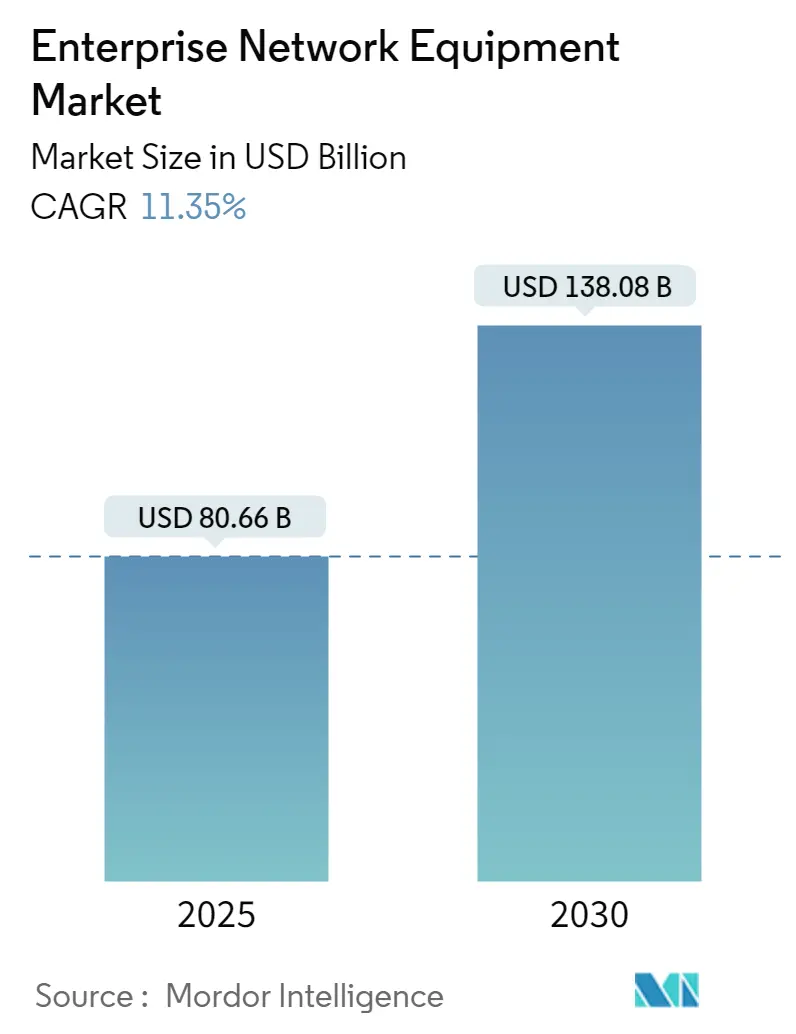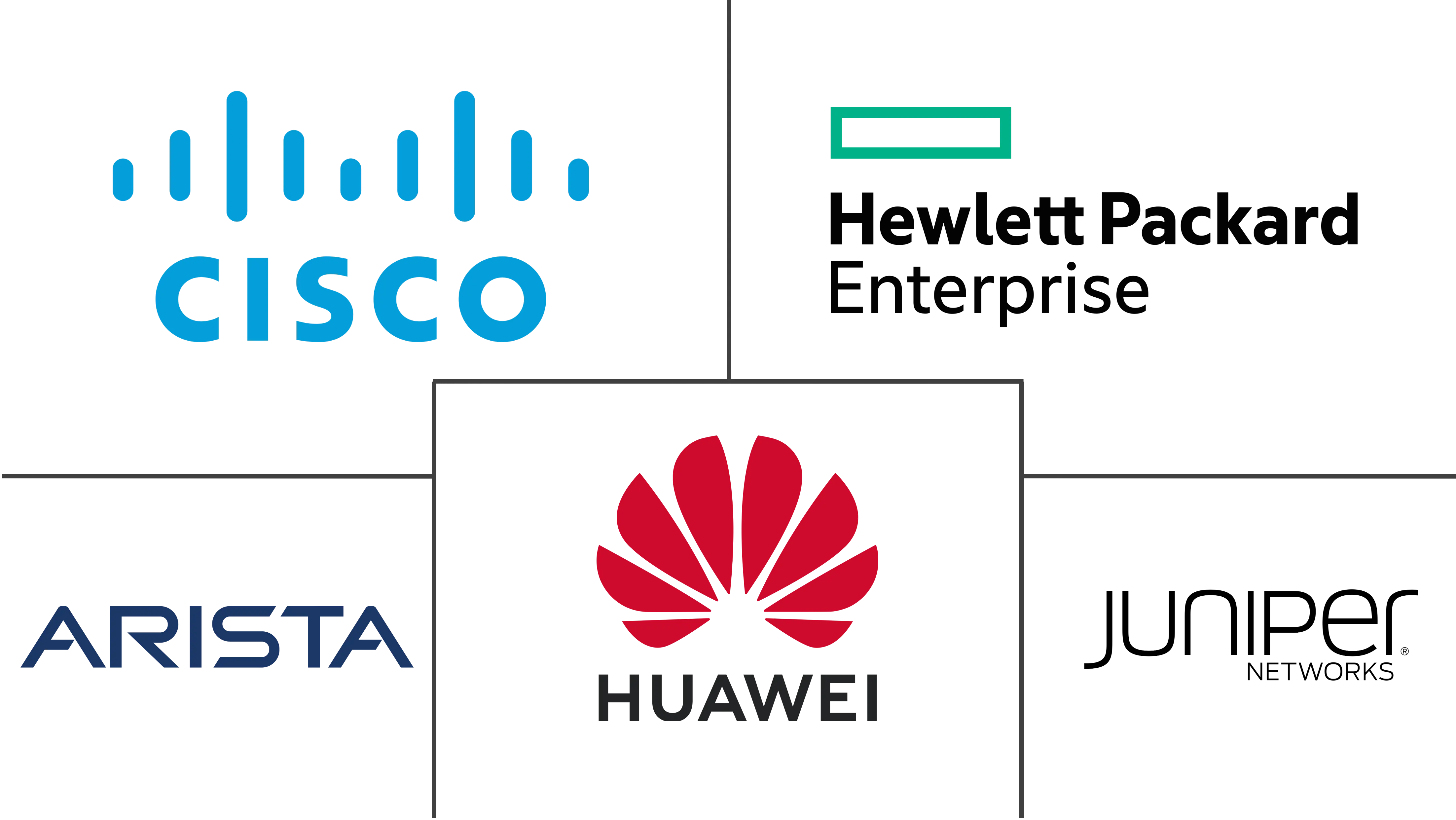
| Study Period | 2019 - 2030 |
| Market Size (2025) | USD 80.66 Billion |
| Market Size (2030) | USD 138.08 Billion |
| CAGR (2025 - 2030) | 11.35 % |
| Fastest Growing Market | Asia Pacific |
| Largest Market | North America |
| Market Concentration | High |
Major Players
*Disclaimer: Major Players sorted in no particular order |
Enterprise Network Equipment Market Analysis
The Enterprise Network Equipment Market size is estimated at USD 80.66 billion in 2025, and is expected to reach USD 138.08 billion by 2030, at a CAGR of 11.35% during the forecast period (2025-2030).
An enterprise network is an enterprise's communication backbone that helps connect computers and related devices across departments and workgroup networks, facilitating insight and data accessibility. It reduces communication protocols, promotes system and device interoperability, and improves internal and external enterprise data management.
- In an enterprise network, all systems should be able to communicate and provide and retrieve information. Therefore, physical systems and devices should be able to maintain and provide satisfactory performance, reliability, and security. Thus, components and technologies such as switches, routers, wireless networks, access points, network security and management, and WAN optimization assist in creating a secure, reliable, and scalable network at a lower cost.
- The significance of network infrastructure is rising along with digitalization. Consequently, there is a rising need for network infrastructure. Additionally, businesses are expanding their networks to accommodate the expanding bandwidth requirements of wireless networks. The market for enterprise network infrastructure is being driven by factors such as the expanding use of mobile devices, the rising need for bandwidth, and the transition to wireless technologies. Additionally, businesses are increasing their investments in network upgrades to increase speed, which would offer a reliable, energy-saving, and cost-effective solution.
- Moreover, enterprises are increasingly favoring advanced technologies and features such as 100G Ethernet switches and the adoption of 802.11 ac standards. For instance, the 802.11ac standard brings opportunities to deliver high-performance and end-device capacity over wireless networks. This enables the enterprise network to support the increasing range of wireless end devices such as smartphones, tablets, new generations of machine-to-machine (M2M) devices, and the Internet of Things (IoT).
- The market for corporate network devices is anticipated to grow in line with the trend of "bring your own device" (BYOD), which epitomizes the idea of any device used anywhere and is driving the demand for invasive wireless networks and mission-critical mobility applications.
- According to the Consumer Technology Association, worldwide spending on smart city developments is anticipated to reach USD 34.35 billion by 2020. This significantly drives the market. Further, the rise of China's middle class, a distinctly urban phenomenon, lifted around 500 million people out of poverty in less than 30 years. It is a testament to cities' power to elevate living standards. China has approximately 500 smart city pilot projects, the highest in the world, covering big and small cities. This potentially demands the rise of network equipment in the coming period.
- The network infrastructure market will be affected by the economic turbulence that has followed in the wake of Covid-19. The impact may be uneven across various sectors, geographies, and vertical industries across the market as the effects of the pandemic continues to play out.
- Telecom network vendors such as Huawei, Samsung, Ericsson, Nokia, and ZTE are facing supply chain issues in the wake of the COVID-19 pandemic. However, equipment installation services will remain in demand despite COVID-19-related challenges, such as rolling out personnel to sites to install new equipment amid the pandemic. Telecom operators still need to deploy small cells, predominantly in urban markets and public venues, that leverage high-band spectrum and additional macros in the field, primarily on existing sites.
Enterprise Network Equipment Market Trends
Network Security is Growing Due to Data Security Concerns
- The market's growth is attributed to the increasing cases of cyber thefts in banking and defense institutions. The growing complexity and diversity of cyber-attacks have driven the need among organizations to implement network security equipment to reduce the likelihood of large-scale data thefts.
- Many organizations are reaching for more robust cybersecurity strategies apart from implementing traditional firewalls and controlling user access. This creates an excellent opportunity for developers to bring new defense approaches to the table. Incorporating AI to develop intuitive, efficient systems will allow businesses to use smart machine capabilities to detect threats early and use proactive strategies in defending their information.
- Due to the rapidly increasing growth of digital organizations, IT professionals consider the lack of visibility as one of the biggest challenges being faced in addressing network threats. Most organizations recognize how critical it is to constantly monitor their network across all users, applications, and devices. Organizations are implementing networking and security teams to work more closely and leverage network infrastructure to extend visibility everywhere and avoid data breaches or cybersecurity threats.
- Additionally, the growing popularity of IoT and BYOD trends has also resulted in the growth of cyber-crimes, forcing organizations to use network security solutions. The rise in connected devices in the region has made enterprise networks more complex. The evolving network landscape has generated the need among enterprises to reassess their network security infrastructure and adopt robust network solutions.
- Moreover, according to Cisco, 46% of network devices will be M2M or IoT in the upcoming years, which are vulnerable to attacks. To fully realize the potential of these connected devices, industries need to be equipped with WANs that are flexible to meet the network demands anticipated over the future.

North America is Expected to Have Significant Market Share
- North America is expected to hold a prominent share of the enterprise network equipment market. Moreover, the region has a strong foothold of network equipment vendors. Some of them include Cisco Systems, Inc., Dell EMC, Juniper Networks, Inc., Extreme Networks, Inc., and Arista Networks, Inc., among others, which contribute to the growth of the market.
- The vendors operating in the region are working on enterprise network equipment technologies to strengthen their product capabilities. An effective long-term work-from-home solution has to deliver a secure, enterprise-like experience that enhances efficiency, creativity, and productivity. Unlike solutions that use repurposed consumer network equipment, Aruba provides enterprise-class telework hardware coupled with plug-and-play installation, identity-based security, and cloud-native management for rapid, simple, and scalable deployment.
- The emergence of trending technologies, such as cloud networking, SaaS-based application, network analytics, DevOps, and virtualization, has encouraged users and businesses in North America to undertake enterprise network equipment products. Also, the rising demand for cloud adoption, digital content, and new data sovereignty laws will further drive the North American region's network equipment market in the near future.
- Also, the advances in automation technology cater to the IT sector's current business needs through smart networks and quick remediation, which continuously check the network and offer a resolution without involving any third-party application.
- United States Department of Defense has invested a massive amount in modernizing its infrastructure in the past. Defense Systems Information Agency announced its plan to upgrade the Defense Information Systems Network (DISN) with 10 gigabits per second (Gbps) transport speeds to a 100 Gbps packet-optical transport system. Such investments are expected to boost the market.

Enterprise Network Equipment Industry Overview
The enterprise network equipment market is moderately competitive and consists of a few market players enjoying a significant market share. A few major players currently dominate the market in terms of market share. These market leaders with significant market shares are focusing on expanding their consumer base overseas. Network equipment should also meet the Restriction of Hazardous Substances (RoHS) directive from the European Union (EU), which makes limited numbers of suppliers meet such standards for enterprise use. These companies leverage strategic collaborative initiatives to increase their market share and profitability. The companies operating in the market are also acquiring start-ups working on enterprise network equipment technologies to strengthen their product capabilities
In March 2022, OneCloud CCaaS composable solutions from Avaya, a provider of solutions to improve and streamline communications and collaboration, and Alcatel-Lucent Enterprise (ALE), a global provider of communications, networking, and cloud solutions, announced a strategic partnership that expands the availability of ALE's digital networking solutions to Avaya customers globally.
Enterprise Network Equipment Market Leaders
-
Cisco Systems Inc.
-
Hewlett Packard Enterprise Development LP
-
Huawei Technologies Co. Ltd.
-
Juniper Networks Inc.
-
Arista Networks Inc.
- *Disclaimer: Major Players sorted in no particular order

Enterprise Network Equipment Market News
- October 2022: A fiber to the x (FTTx) and connected home-themed series of broadband solutions and products were introduced by ZTE Corporation, a global provider of information and communication technology solutions, at an event held in conjunction with Networks X in Amsterdam, the Netherlands. A 50G PON&10G PON Combo solution, the Light ODN solution, and a business optical gateway were included in the FTTx-themed series. ZTE thinks optical networks should have straightforward deployment, seamless upgrades, and straightforward operation and maintenance.
- July 2022: Alcatel-Lucent Enterprise (ALE), a provider of communications, cloud, and networking solutions tailored to customers' industries, is working with SBP Digital Service Company Limited (SBP), a division of Boonrawd Supply Chain Company Limited, to enhance the development of various management systems using standards-based network hardware.
Enterprise Network Equipment Industry Segmentation
Enterprise networking is traditionally centered on LAN standards with hardware switches, router devices, ethernet cabling, WIFI connections, and integrated firewall software all commonly used to create a Local Area Network.
The Enterprise Network Equipment Market is segmented by Type (Switches, Routers, WLAN, and Network Security), and Geography (North America (United States, and Canada), Europe (Germany, United Kingdom, France, and Rest of Europe), Asia-Pacific (India, China, Japan, and Rest of Asia-Pacific), and Rest of the World).
The market sizes and forecasts are provided in terms of value (USD million) for all the above segments.
| Type | Switches | ||
| Routers | |||
| WLAN | |||
| Network Security | |||
| Other Types | |||
| Geography | North America | United States | |
| Canada | |||
| Europe | United Kingdom | ||
| Germany | |||
| France | |||
| Rest of Europe | |||
| Asia Pacific | China | ||
| India | |||
| Japan | |||
| Rest of Asia Pacific | |||
| Rest of the World | |||
Enterprise Network Equipment Market Research FAQs
How big is the Enterprise Network Equipment Market?
The Enterprise Network Equipment Market size is expected to reach USD 80.66 billion in 2025 and grow at a CAGR of 11.35% to reach USD 138.08 billion by 2030.
What is the current Enterprise Network Equipment Market size?
In 2025, the Enterprise Network Equipment Market size is expected to reach USD 80.66 billion.
Who are the key players in Enterprise Network Equipment Market?
Cisco Systems Inc., Hewlett Packard Enterprise Development LP, Huawei Technologies Co. Ltd., Juniper Networks Inc. and Arista Networks Inc. are the major companies operating in the Enterprise Network Equipment Market.
Which is the fastest growing region in Enterprise Network Equipment Market?
Asia Pacific is estimated to grow at the highest CAGR over the forecast period (2025-2030).
Which region has the biggest share in Enterprise Network Equipment Market?
In 2025, the North America accounts for the largest market share in Enterprise Network Equipment Market.
What years does this Enterprise Network Equipment Market cover, and what was the market size in 2024?
In 2024, the Enterprise Network Equipment Market size was estimated at USD 71.51 billion. The report covers the Enterprise Network Equipment Market historical market size for years: 2019, 2020, 2021, 2022, 2023 and 2024. The report also forecasts the Enterprise Network Equipment Market size for years: 2025, 2026, 2027, 2028, 2029 and 2030.
Our Best Selling Reports
Enterprise Network Equipment Industry Report
The Global Enterprise Networking Equipment Market is witnessing remarkable growth, fueled by the rising demand for sophisticated network systems across diverse sectors, including Banking, Financial Services and Insurance (BFSI), retail, IT & telecommunications, automotive, and government & utilities. This industry, which encompasses Ethernet switches, enterprise routers, WLAN, and network security, is expanding notably in regions like North America, Europe, Asia Pacific, and South and Central America, with Asia Pacific experiencing significant growth due to its robust IT sector. The surge in adoption of cutting-edge technologies such as machine learning (ML), artificial intelligence (AI), 5G, cloud computing, the Internet of Things (IoT), and edge computing is revolutionizing networking infrastructure, despite increasing complexity and operational costs. These advancements are enabling new applications and services, impacting society profoundly. Moreover, the trend towards outsourced networking solutions is accelerating, driven by the desire for cost efficiency and access to expertise. The enterprise networking equipment market is highly competitive, with key players focusing on product innovation, strategic partnerships, and market expansion to meet the evolving needs of businesses worldwide. For detailed insights, Mordor Intelligence™ Industry Reports offer comprehensive analysis, including market share, size, revenue growth rate, and a forecast outlook, available as a free report PDF download.




